The biggest reason that climbers tend to get stuck at their grade in climbing is that they aren’t climbing the right grade when it comes to pushing themselves. They either spend a lot of their time attempting climbs that are too far ahead of their current climbing grade foundation or they aren’t attempting beyond their current comfort zone.
To counter this issue, many climbing coaches use the pyramid worksheet method. This worksheet not only tracks your climbing grade but also provides guidance for when you should start climbing at the next grade.
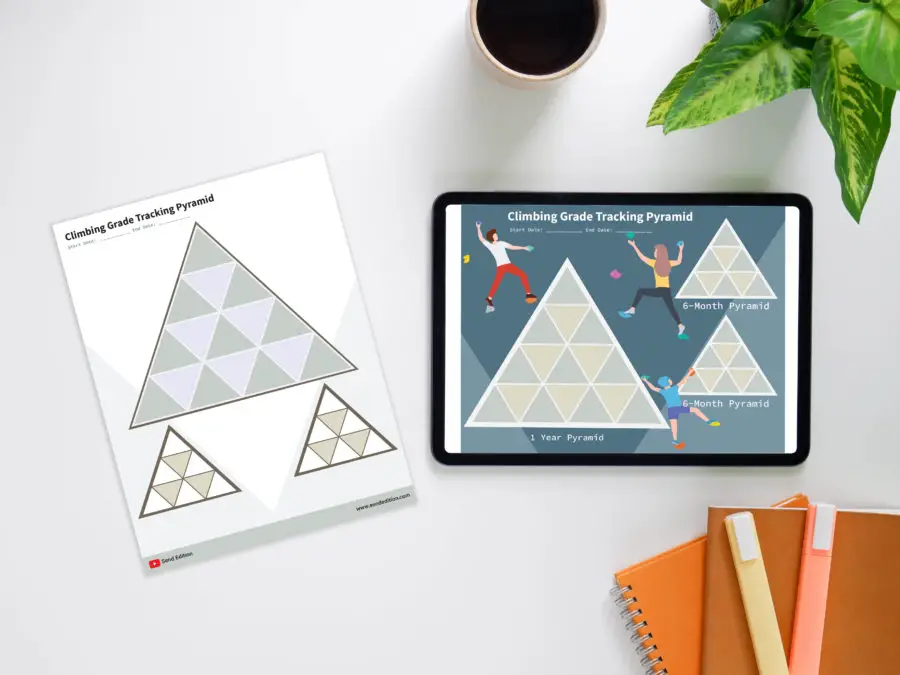
What is A Climbing Pyramid
A Climbing Pyramid is a visual way of tracking the climbs that we complete and shows us what grades we should be working on next. In addition, it can help prevent us from getting stuck at a specific grade. It has been used by many climbing coaches and was actually introduced to me when I started getting serious about improving my climbing.
There is another climbing pyramid talked about when it comes to grade chasing and is used to look back at your training and learning what grade you should focus on to build out your base. However, the climbing pyramid we are referring to in this article is how. to move forward, not how to look backward.
How To Use A Climbing Pyramid
To use a climbing pyramid, you will draw a pyramid and fill in each row with the climbing grades that represent what grade you should be completing. The bottom row should be routes that you can mostly flash but it’s ok if you occasionally need a couple of tries to complete that grade.
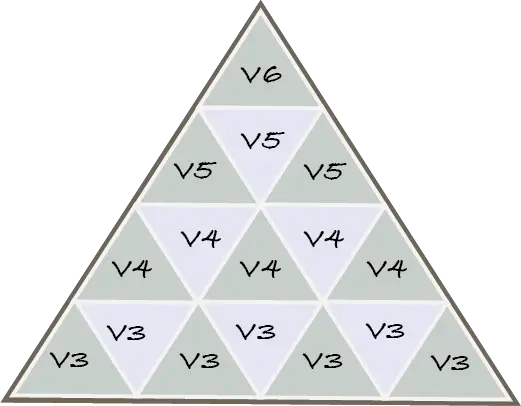
For this example, we are using bouldering V-grades but it works for rope climbing as well. Since the climber tends to flash V3s, we have put V3s as the bottom row of the pyramid. Keep in mind that this pyramid is based on your current grade, not your goal grade. After you have created your pyramid, it’s time to break down the pyramid even more so you know what grades you should be working on.
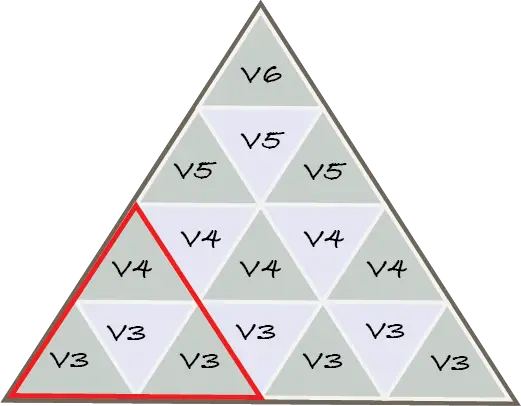
Start by completing the smallest of the pyramids. In the case of this example, the climber will complete three V3s and then one V4. You don’t have to flash these climbs, you just need a clean completion of the climb. This means that you don’t fall, take breaks, or grab quickdraws while completing the climb.
After you have completed the smaller pyramid, it’s time to start working on the medium size pyramid.
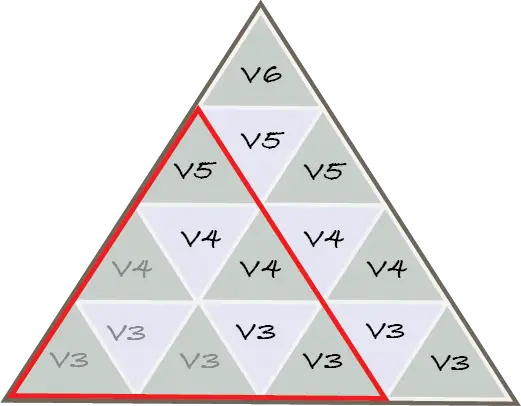
As you can see in the example above, the climber completed the smallest triangle (greyed out V-grades). To complete each triangle, you don’t have to complete the climbs in order of difficulty. In fact, by going in order of difficulty, you are more likely to get caught in that grade if you go in order so consider trying the route at the top of your medium size pyramid.
Climbers tend to treat this pyramid as a project tracker and that is probably the easiest way to describe it.
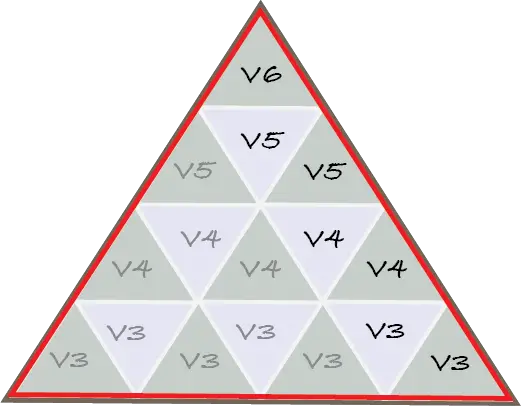
As you get to the top of your pyramid, the grade at the tip may still feel practically impossible. However, trying the route a few times while trying to complete the pyramid will help you build confidence. Additionally, make sure that you complete all of the routes on the pyramid before considering it complete. This will give you a good foundation of route grades so you are more likely to keep progressing and are less likely to get stuck at a grade.
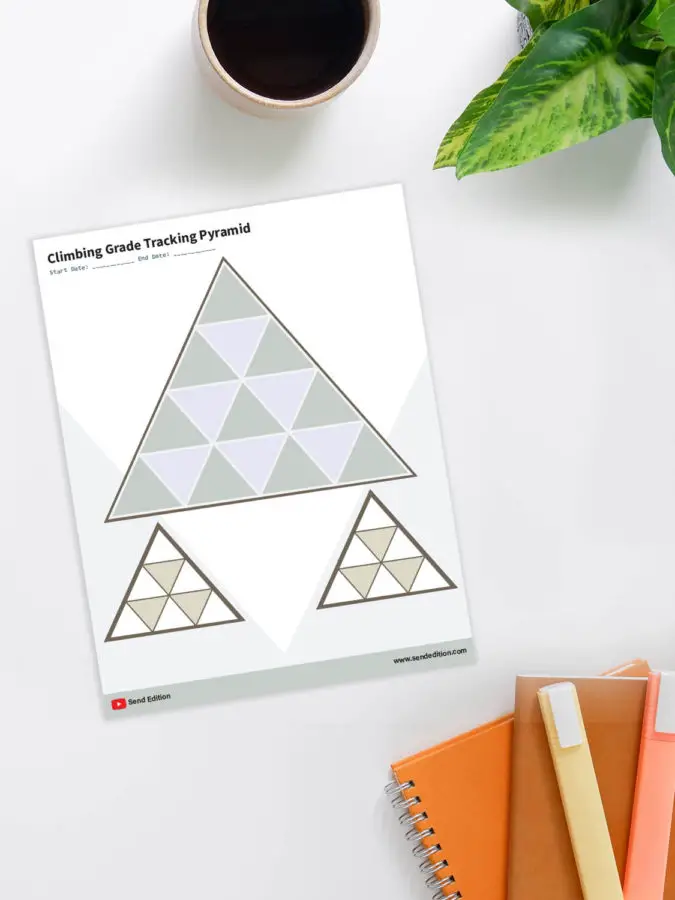
Common Mistakes Climbers Make While Using the Pyramid
Just like any other training for climbing, there are a few common mistakes that you should avoid when using the pyramid for your training.
Mistake 1: Updating Pyramid Before Completing Your Pyramid
This is one of the most common mistakes for people when they are first introduced to the pyramid. For example, once I finished the medium-sized pyramid, I tended to create a completely new pyramid with the grade a level up from my previous one.
The problem with this is that the grade at the top of your first pyramid was never accomplished and still seems practically impossible. This made it so that I was getting caught on the second line of grades to the top and it was harder for me to complete the pyramid.
Instead, complete the pyramid completely (even if you finish a route of the grade at the top of the pyramid) so that you have a good foundation of climbing routes under your belt.
Mistake 2: Completing Pyramids Row by Row
Another common mistake that climbers tend to make is that they complete a row of climbs before going onto the next grade. This is probably because climbers tend to be more comfortable repeating grades than they are at levels up to the next grade.
However, for this pyramid to be as effective as possible, it is ideal to complete the pyramid by going from the mini pyramid to the medium size pyramid to the full pyramid. This will ensure that you are pushing your limits throughout your training by completing harder routes at the same time as building a decent foundation.
Tips for Using Pyramids for Climbing Training
The pyramids are a great way to improve your training focus and if you’re looking for some tips to make it even better, here are some that I’ve learned over the past few years as well as some from professional climbing coaches.
Use Smaller Pyramids For Individual Training Days or Training Cycles
Once you get into the higher grades, leveling up your climbing can be a lot longer and harder process. For those of you that feel completely stuck on your pyramid, consider creating smaller pyramids that mimic that of the medium size pyramid for your training day or training cycle.
Create Pyramids Based On Your Current Skill Level
Sometimes, climbers get excited and use the pyramid as their goal tracking. Though this can be a fun visual way to see your progress toward your ultimate goal, it is likely that the pyramid of your dreams is a little ways away from your current grade and can make training frustrating.
For this reason, it is ideal that you use the climbing grade that you can sometimes flash as your base level. Once you complete the Pyramid, then you can move to the next grade.
How Many Routes of Each Grade Should You Climb Before Climbing Harder Routes?
There is an optimal amount of climbs you should complete before attempting harder routes but it’s not as many as you may think. For every three routes of one grade you complete, you should be attempting a climb that is one grade above it. This doesn’t mean you need to finish a harder route for every three routes you climb but you should at least be touching and attempting moves of a harder route.
A challenge I seemed to be plagued with as a new climber (and still tend to fight a little) was getting stuck at specific grades. For example, near the beginning of my climbing experience, I started flashing V3 boulder problems before even considering trying a V4. This tends to be common for a lot of climbers and is, unfortunately, a common reason why climbers get caught on grades.
To counter this problem, climbing coaches around the world have started to implement what is called Climbing Pyramid. This pyramid helps climbers know what grades they should be focusing on and when they should be attempting harder climbs.
